► New Stelvio, new XC60, new Q5
► Petrol SUVs tested
► Which one is best?
Some phrases we write so often it’d be handy to have them accessed via a keyboard shortcut. Things like ‘magnetorheological dampers’ to save me looking up the spelling and ‘according to a 6ft colleague’ when writing about interior space. But our hypothetical shortcut key number one has to be this old chestnut: ‘Is this the car that will finally make Alfa Romeo great again?’
In the case of the Stelvio, it really might be. Forget about the Ferrari-inspired Quadrifoglio monsters, and even the regular Giulia, because they’re window dressing besides the Stelvio.
If the Stelvio takes off, it’ll be rags to riches for Alfa, because it’s the car it desperately needs to crack China and the US, markets in which it currently has almost no presence, but which Alfa thinks could account for 30% each of its global sales with an SUV in the armoury. Europe, on which Alfa currently relies so heavily, will mop up the other, still significant, 40%.
But the Stelvio has arrived into a market teeming with quality rivals, including the excellent but pricey Porsche Macan, the actually-only-okay-but-everyone-seems-to-think-it’s-excellent Jaguar F-Pace, and the two cars you see on this page, the Audi Q5 and new Volvo XC60.
Which is how, fresh off the boat, our left-hand-drive Italian has come to south Wales, following in the footsteps of many of its countryfolk in the interwar years, though it’s got bigger plans than selling ice cream to miners. Over the next couple of days we’ll be tackling gnarly B-roads, demolishing hours of motorway miles and pretending we’re François Delacour to come up with an SUV winner.
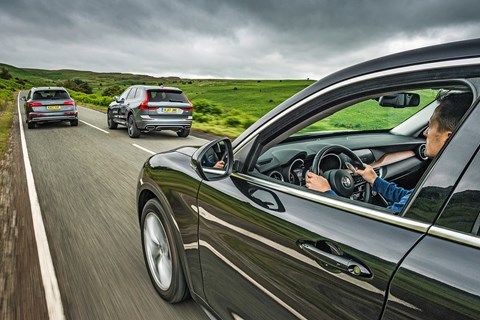
The Stelvio gets off to such a good start that the other two are squealing ‘jumped the gun!’. First off, it looks fantastic. Recognisably Alfa, recognisably Italian, it has curves instead of creases, that distinctive heart-shaped grille and a backside sports cars will try to pinch as you drive by – at least on the streets of Milan, if not Crickhowell.
And second, it’s the cheapest of the three cars here. Excluding the nutty 503bhp Quadrifoglio that’ll come later, there are four trim choices: Stelvio, Super, Speciale and Limited, the first of which will set you back £33,000. You’ll pay £38,035 for the cheapest Q5 and £37,205 for the most basic XC60.
We’ve stepped a little further up the pricing ladder for this test, by going for performance-themed trims in each case. So the Alfa is in Super-spec, but still mated to the standard 2.0-litre turbo petrol engine, bringing the final bill to £36,890. The Audi is our long-term Q5 S-Line, which carries a basic price of £42,150, and an XC60 in the R-Design trim we’ve got here would carve £40,405 out of your wallet. But rest assured, you’ll be looking at nearer £50k for the Volvo and Audi by the time you’ve pick ‘n’ mixed at the options department.
Volvo XC60: big seller just got much better
Just to wrong-foot you, let’s start with the XC60, because its success is every bit as important to Volvo as the Stelvio’s is to Alfa. You probably never paid much attention to the old XC, but Volvo shifted a million of them. This new one, developed under Chinese control, has big boots to fill. But it doesn’t just fill them – it bursts out of them. This new XC has real presence, something the old car never had, its elongated roofline, shallow windows and trademark pronounced Volvo hips riffing on the company’s back catalogue of fast wagons.
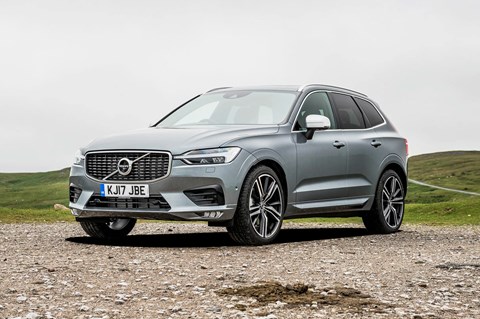
Inside, it’s just as impressive. Our R-Design car’s cabin is dominated by seats with more splayed wings than a Victorian butterfly display. They’re what a 911 GT3’s Recaros might look like on dress-down Friday, and the front pair is separated by a ridiculously oversized transmission tunnel/centre console so deep it’d make a supercar driver feel at home.
Volvo XC60 cars for sale
The detailing is lovely: the little thumbwheel used to select driving modes is so much better looking and positioned than the Audi equivalent; the rotary dial you twist to start the engine is a beautiful, literal twist on the now ubiquitous starter button.
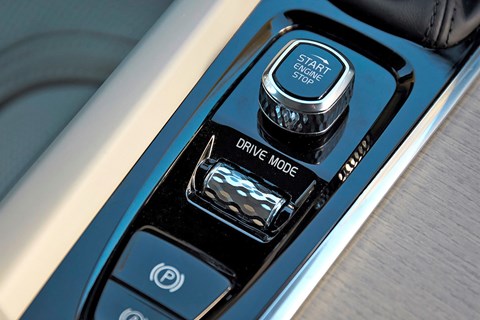
And then there’s the screen. Bright, beautifully detailed and mostly logically laid out, you can imagine this helping seal the deal when you scroll through its pages in a showroom.
Unfortunately, cars have this annoying habit of moving. And since even Volvo hasn’t cracked full autonomy yet (though a partial system is optional), lumping almost every function of the car onto the screen might get annoying, and definitely compromises safety. Pretty ironic given the Volvo message, huh?
Audi Q5: our SUV shines through
There are definitely times when you wish the Audi’s beautifully rendered screen would also respond to touch inputs, like its Porsche Macan cousin. In addition to the standard scroll wheel ours has the optional track pad, which does much same job as a touchscreen but robs valuable console space. The combination of rotary dial and surrounding buttons is highly intuitive and after only a short time in the car you can perform functions without taking your eyes off the road at all. Ah, just like the old days.
But if you do glance down at the console you might notice this interior is built of even better materials than the Volvo’s, and the optional Virtual Cockpit display has more to show than the Volvo’s also-digital (but standard) version.
Audi Q5 cars for sale
Glance over your shoulder and you’ll see that the Q5 has less rear space than the Volvo or the Alfa. It’s certainly not cramped, but comparison tests are ruthless when it comes to pricking the bubble of big headedness a car can acquire when driven in isolation. Suddenly, here in Wales, I’m seeing chinks in our Q5‘s armour that I hadn’t noticed before.
But I’m also seeing the Audi’s already apparent strengths magnified, because on the road it leaves the Volvo standing – almost literally. The Volvo’s no slouch. At 251bhp, its 2.0-litre T5 (but actually turbo-four) motor is a small stable’s worth of ponies stronger than the Q5’s conceptually similar 249bhp 2.0 TFSI. But the XC is also 15lb ft down, 59kg up, and has all the charisma of a power drill.
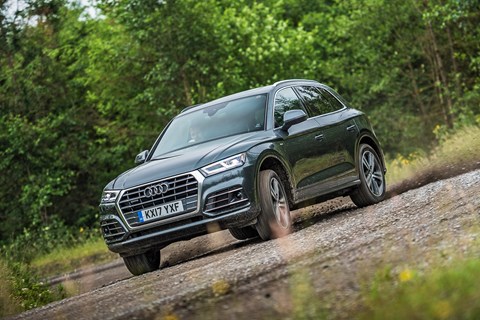
It’ll hit 62mph in 6.8sec, but there’s almost no pleasure to be had in doing it. The engine is bland, meaning I’ll shed no tears when Volvo makes good on its recent announcement that it’s ditching non-electrified engines.
The Audi feels like a TT in comparison. Pitched between a Golf GTI and a Golf R on power, the TFSI Q5 is deceptively rapid, taking half a second out of the Volvo in the sprint to 62mph, and besting it by 10mph at the top end. Which might not seem that important in itself, but it’s an indicator of how much extra overtaking go the Audi has, not just off the line, but at motorway speeds too.
But the Q5’s appeal goes beyond its ability to get Timmy to school before Tarquin next door. The 2.0 TFSI engine never seems overly charismatic even in cars like the Golf GTI, but in this context it’s a gem. It whips up revs out of nowhere and keeps pulling hard long after the others have lost interest. And because it’s the only one of our three to employ a dual-clutch ‘box, ratios are swapped like sprinters in a relay race.
Which isn’t to suggest the Q5 gets perfect marks here. It deserves some Golf R-style sound effects and the mapping of the S-Tronic transmission in its default Drive mode doesn’t seem as slick as the others’ eight-speed autos.
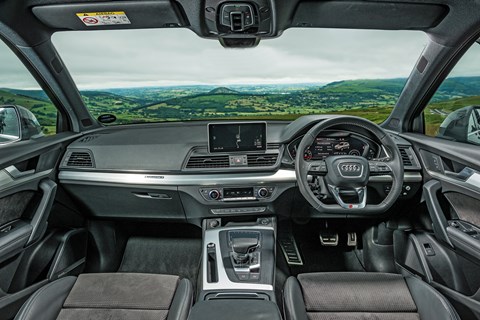
But it gets almost everything else spot on. The steering doesn’t fizz with feedback, but the gearing, weighting and just the feel of the wheel itself (excepting the awful flat bottom section) connect you to a front end that feels unflappably secure, and inspires more confidence than the Volvo’s over-light rack.
This Q5’s got the air suspension, an expensive £2000 option. You’ll not punt it through many corners in Comfort mode before reaching annoyingly far across the console to the Drive Select button to engage Auto or, better yet, Dynamic mode.
Suitably Dynamised, the Q5 delivers a bit of a shock. The body control is excellent, and although this car features the new generation of quattro four-wheel-drive system that disengages the rear wheels to save fuel when not needed, there’s never a hint of slip or torque steer.
Alfa Romeo Stelvio: Italian, but in a good way
But then you jump in the Alfa and you realise how far Audi didn’t push the Q5. And how much further you can push the Alfa. We’re not talking about outright grip here, but what happens on the way.
The Stelvio is almost as fun to drive as a Porsche Macan and even more responsive. Don’t pay much heed to the steering’s 2.2 turns lock-to-lock: like an old 156 the Stelvio has the kind of turning circle that’d make an F1 car seem like the perfect town runabout.
That said, this is still a mighty quick steering set-up for a saloon car, let alone an SUV, and it’s mated to excellent body control that keeps the car supremely level. On top of that, unlike the Audi, the Alfa’s drivetrain defaults to rear-wheel drive, only bringing the front wheels into play when needed, and that gives a subtly different dynamic to the handling, even when traction is good.

The noisy 2.2 diesel that’ll likely swallow the lion’s share of sales hasn’t quite got the pace to make the best of this chassis, but the 2.0 petrol has. Kicking out 276bhp – and pushing the other two into the weeds as it does so – the Stelvio can get to 62mph in only 5.7sec.
But despite its pace, the Alfa’s engine is a curiously unsatisfying experience. There’s a huge rush of turbo-diesel-style thrust at the low and midrange, but it’s not sustained, and the rev counter turns red at a disappointingly low 5800rpm. And it sounds almost as dull as the Volvo. All of which means the Alfa is demonstrably quicker than the Audi, but not a great deal more engaging.
And there are other problems. The Stelvio’s ride is poor and the Giulia parentage means there’s no optional air suspension to add a layer of sophistication on the road, or to improve the ground clearance off it. To be fair, none of the cars here has the clearance, the off-road kit (hill descent control is as good as it gets) or the correct rubber to tackle the serious sections at Walters Arena, which is where we took them – regular readers might remember this is where I came to get muddy in an Ariel Nomad a couple of years back.
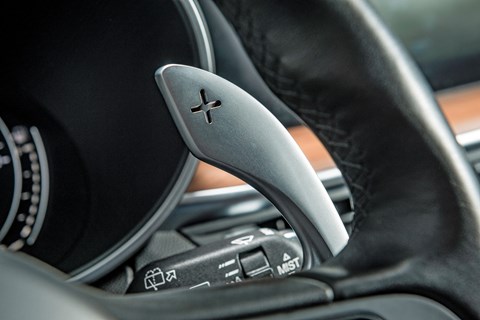
This time we skip the rock crawl and concentrate on the brawl, ragging the three through the miles of tracks like we’re playing sweeper on a rally stage. The Volvo feels safe and understeery. The rear-biased Alfa feels like it wants to oversteer, if only its ESP would let it. And the Audi’s does. A dab on the brakes on the way into a corner or a bootful of gas coming through it has the rear end slewing round in a most agreeably un-Audi manner. Brilliant. And absolutely irrelevant.
Poking around and chewing the fat
So let’s get a little closer to real life – pointedly, what on earth was Alfa thinking when it sent this interior out to battle with Europe’s premium best? The Stelvio is actually slightly roomier than the Q5, and though it’s got the smallest boot by volume, you’d not know it to look at. But the more you prod and probe, the worse it gets.
The high point is the gorgeous pair of supercar-style metal shift paddles that you’ll almost never use because the lowly rev limit means the car will have changed up before you get the chance. From there it’s downhill – including the location of the instrument binnacle, which gives you the impression of sitting on, and not in, the Stelvio.
The rear bench is flat and hard, as are too many of the plastic surfaces. You go to tug the door shut and feel how thin the padding is beneath your thumb. You extend a finger to what looks like a BMW-style touchpad atop the copycat iDrive dial, but it’s just a plain old dial. So you get busy with that and discover the multimedia system looks and feels at least an entire generation behind its rivals’.

The Alfa gets plenty right. It’s cheap and fast, it handles brilliantly, and barely seems to suffer dynamically in the conversion from saloon to SUV, while gaining massively in other areas. Passenger space, boot capacity and residuals are also miles better, and the claimed 40mpg economy and standard-fit safety kit that includes autonomous emergency braking means Alfa has an eye on the sensible stuff.
For all that, it only costs a few grand – or a few pounds per month – more than a Giulia. Unless you’re dead-set against driving an SUV you’d be mad to go for the saloon, which, incidentally, won’t ever be joined by a traditional estate spin-off.
Ummming and ahhhing…
But would you be mad to pick the Stelvio over its rivals? For all the Stelvio gets right, there’s plenty it doesn’t, and when it’s time to divvy the keys up for the four-hour drive home from south Wales, the fastest, newest and sexiest of our trio seems about as in demand as the fat, pigeon-toed kid when five-a-side teams are being picked at school.
Because, as we’ve discovered over the past two days, the ride is as poor as the noise suppression, and the spacious interior is marred by a low-quality interior and a second-rate infotainment system. It’s the most tiring car to spend time in and just doesn’t feel like 40 grand’s worth of SUV in the way the Volvo does. Yes, the Alfa is a little cheaper. But it never lets you forget it.
The XC60, on the other hand, is a bit of a revelation. Having not driven it before the test I’d already mentally pegged it back based on experience of the old one, a blandly competent asexual SUV. But somehow this one is in contention for the top spot.
Handsome, well equipped and roomy, the XC is only let down by a slightly fidgety ride, at least in sportier R-Design trim with the monster 21-inch rims, and an engine that feels short on character and push compared to the other two. But don’t dismiss it.
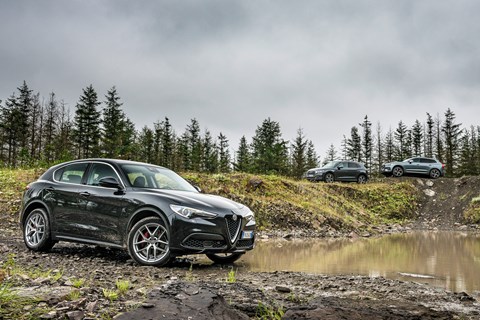
It might not out-handle or out-accelerate the Stelvio, but it’s playing the long game, and is armed to ensure that two years down the line you still feel great about having picked it, long after the novelty of the Alfa’s apex-clipping abilities has worn off and its faults have worn you down.
Which leaves the Q5. Not the biggest car here, not the fastest, or the cheapest to buy, but the car with the best blend of abilities. Yes, it gets the usual Audi stuff right, the slick design and decent build quality, but it’s genuinely fun to drive when you want it to be, and the perfect silent partner when you don’t. This is one of the quietest, most relaxing motorway cars I’ve ever driven. That might not be sexy, or techy, not the kind of thing that marketing people want to champion, but it matters.
The Alfa still has clear appeal and should sell in huge numbers. I hope it does, if only so that Alfa can reinvest some of those profits to ensure Stelvio Mk2 really can meet its premium rivals head-on.
Verdict
1st place: Audi Q5
Brilliant all-rounder; Q5 is great to drive, painless to live with and has the best engine here.
2nd place: Volvo XC60
Another hit from Volvo v2.0. Stylish, well screwed together and well equipped, it’s almost a winner.
3rd place: Alfa Romeo Stelvio
Huge fun when you’re in the mood, usefully spacious and the cheapest here, but below-par in too many areas.
Check out the rest of our CAR comparison tests here